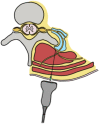Erector Spinae Plane Block and Chronic Pain: An Updated Review and Possible Future Directions
- PMID: 37626959
- PMCID: PMC10452136
- DOI: 10.3390/biology12081073
Erector Spinae Plane Block and Chronic Pain: An Updated Review and Possible Future Directions
Abstract
Chronic pain is a common, pervasive, and often disabling medical condition that affects millions of people worldwide. According to the Global Burden of Disease survey, painful chronic conditions are causing the largest numbers of years lived with disability worldwide. In America, more than one in five adults experiences chronic pain. Erector spinae plane block is a novel regional anesthesia technique used to provide analgesia with multiple possible uses and a relatively low learning curve and complication rate. Here, we review the erector spinae plane block rationale, mechanism of action and possible complications, and discuss its potential use for chronic pain with possible future directions for research.
Keywords: anesthesia; chronic pain; conduction anesthesia; review.
Conflict of interest statement
The authors declare no conflict of interest.
Figures



Similar articles
-
Early experience with erector spinae plane blocks in children.Paediatr Anaesth. 2020 Feb;30(2):96-107. doi: 10.1111/pan.13804. Epub 2020 Jan 27. Paediatr Anaesth. 2020. PMID: 31883421
-
Continuous erector spinae plane block versus thoracic epidural analgesia in video-assisted thoracic surgery: a study protocol for a prospective randomized open label non-inferiority trial.Trials. 2021 May 4;22(1):321. doi: 10.1186/s13063-021-05275-9. Trials. 2021. PMID: 33947442 Free PMC article.
-
A Comparative Study of Placebo Versus Opioid-Free Analgesic Mixture for Mastectomies Performed Under General Anesthesia Along With Erector Spinae Plane Block.Cureus. 2023 Jan 31;15(1):e34457. doi: 10.7759/cureus.34457. eCollection 2023 Jan. Cureus. 2023. PMID: 36874747 Free PMC article.
-
Comparison of Thoracic Erector Spinae Plane Block With Thoracic Paravertebral Block for Pain Management in Patients With Unilateral Multiple Fractured Ribs.Pain Physician. 2022 Sep;25(6):483-490. Pain Physician. 2022. PMID: 36122257 Clinical Trial.
-
Efficacy of erector spinae plane block for analgesia in breast surgery: a systematic review and meta-analysis.Anaesthesia. 2021 Mar;76(3):404-413. doi: 10.1111/anae.15164. Epub 2020 Jul 1. Anaesthesia. 2021. PMID: 32609389
Cited by
-
Effect of Continuous Erector Spinae Plane Block on Postoperative Recovery in Patients Undergoing Minimally Invasive Cardiac Surgery: A Prospective, Randomized Controlled Clinical Trial.Curr Med Sci. 2024 Dec;44(6):1103-1112. doi: 10.1007/s11596-024-2593-4. Epub 2024 Dec 14. Curr Med Sci. 2024. PMID: 39673581 Clinical Trial.
-
The Effectiveness of Ultrasound-Guided, Continuous, Bilateral Erector Spinae Plane Block in Perioperative Pain Management of Patients Undergoing Colorectal Surgery: A Randomized, Controlled, Double Blind, Prospective Trial.J Clin Med. 2023 Dec 1;12(23):7465. doi: 10.3390/jcm12237465. J Clin Med. 2023. PMID: 38068517 Free PMC article.
-
Optimizing post-thoracotomy pain management: comparing erector spinae vs. paravertebral block in thoracotomy patients: a prospective randomized study.BMC Anesthesiol. 2025 Jul 30;25(1):368. doi: 10.1186/s12871-025-03237-1. BMC Anesthesiol. 2025. PMID: 40739476 Free PMC article.
-
Erector Spinae Plane Block for Chronic Lumbosacral Pain: A Case Report.Orthop Rev (Pavia). 2024 Oct 30;16:124769. doi: 10.52965/001c.124769. eCollection 2024. Orthop Rev (Pavia). 2024. PMID: 39624474 Free PMC article.
-
The Erector Spinae Plane Block with 20 or 30 mL of 0.25% Bupivicaine Provides Equivalent Postoperative Analgesia after Mastectomy: A Prospective Randomized Trial.Turk J Anaesthesiol Reanim. 2025 Feb 11;53(1):5-11. doi: 10.4274/TJAR.2024.241730. Turk J Anaesthesiol Reanim. 2025. PMID: 39932041 Free PMC article.
References
-
- Global Burden of Disease Study 2013 Collaborators Global, regional, and national incidence, prevalence, and years lived with disability for 301 acute and chronic diseases and injuries in 188 countries, 1990–2013: A systematic analysis for the Global Burden of Disease Study 2013. Lancet. 2015;386:743–800. doi: 10.1016/S0140-6736(15)60692-4. - DOI - PMC - PubMed
-
- Scholz J., Finnerup N.B., Attal N., Aziz Q., Baron R., Bennett M.I., Benoliel R., Cohen M., Cruccu G., Davis K.D., et al. Classification Committee of the Neuropathic Pain Special Interest Group (NeuPSIG). The IASP classification of chronic pain for ICD-11: Chronic neuropathic pain. Pain. 2019;160:53–59. doi: 10.1097/j.pain.0000000000001365. - DOI - PMC - PubMed
Publication types
LinkOut - more resources
Full Text Sources

